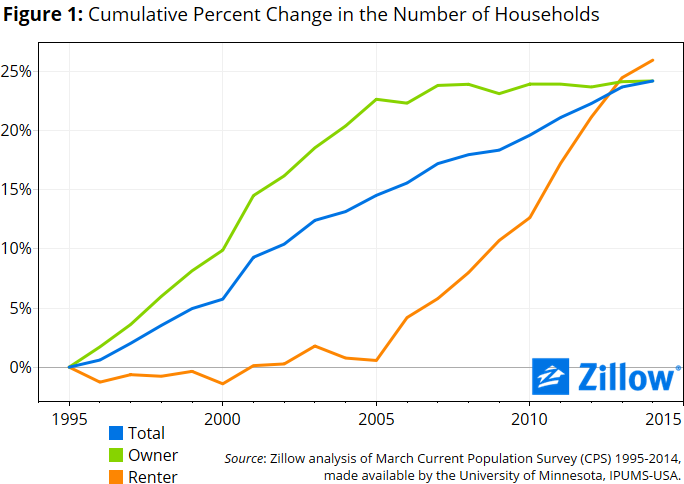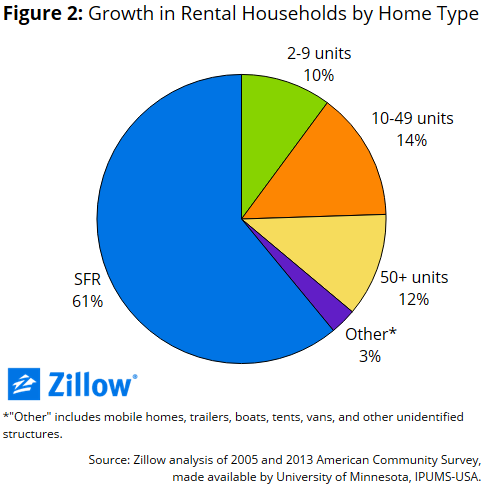Over the past 20 years, the number of U.S. households has increased by roughly 25 percent, according to the Census Bureau’s annual March Current Population Survey (CPS).[1] But the overall trend obscures two very different decades.
Between 1995 and 2005, essentially all of the growth in the number of households was driven by new homeowners. But in the decade from 2005 through 2014, essentially all of the growth in the number of households was driven by renters (figure 1).
Growth in renter households since 2005 has largely been driven by a surge in rentals of single-family residences. Of the increase in renter households between 2005 and 2013, almost two-thirds can be attributed to more renters living in single-family homes.[2] Slightly more than one-third of the growth in renter households over the same time has come from tenants in more traditional multi-family rental buildings, with the biggest bump coming from renters in mid-sized properties between 10 and 49 units (figure 2).
The surge in renting households over the past decade has been driven by a number of factors. The Great Recession and the foreclosure crisis that followed drove much of this growth, as foreclosed families met their housing needs by renting the kinds of single-family homes they may have otherwise purchased. Even as the recovery has progressed, many of these families may still look to the flexibility provided by rentals as they move for new jobs or other opportunities. This continued demand is a welcome development among investors who bought huge numbers of distressed single-family homes at a steep discount during the recession and subsequently converted them to rentals.
Additionally, while the Great Recession forced many Americans to move in with roommates or family, the recovery is now causing these doubled-up households to unwind. And while many of these new households will look to buy a home, it’s likely that many more – particularly younger new households – will look to rent as a middle step before buying a home, further boosting rental demand.
Finally, and perhaps paradoxically, high rents themselves could be driving a surge in rental households. Since 2000, rents have grown at roughly twice the pace as incomes. These high rents make it very difficult for many would-be buyers to save up for a down payment on a home, keeping them in rental housing for longer than they otherwise may have been were rental growth not as high.
Given these factors, the growth in renter households may not be particularly surprising, but the recent trend is no less notable because of it. The bursting of the housing bubble left many Americans with the painful lesson that homeownership is not the best option for everyone. But renting is not the best choice for everyone either. A housing market driven entirely by renters is no more sustainable than a housing market driven entirely by owners. In more normal times, we would expect to see more balance in the mix between new owners and new renters. The continued growth in renter households suggests that balance has yet to return to the nation’s housing market, at least not as of March 2014.
Still, much has changed over the past nine months. By most expectations, housing markets will further normalize over the coming year, boasting a better mix of renter and owner households. However, given the dystopic experiences of the past two decades, it’s still tough to tell what that mix might look like.
[1] There is some debate about the reliability of the various surveys used to measure household formation. By most accounts, the March CPS likely overstates the actual number of households (see “Lawler: Household Estimate, If True, Disturbing; Fortunately, Probably Isn’t,” on the Calculated Risk Blog). Comparisons of subgroups reported in the March CPS may still yield informative results.
[2] These data are from the 2013 American Community Survey (ACS) rather than the March Current Population Survey (CPS) data used to chart the change in renter and owner households. The ACS data allow us to take a finer-grain look at structure types, but are only available through 2013.

